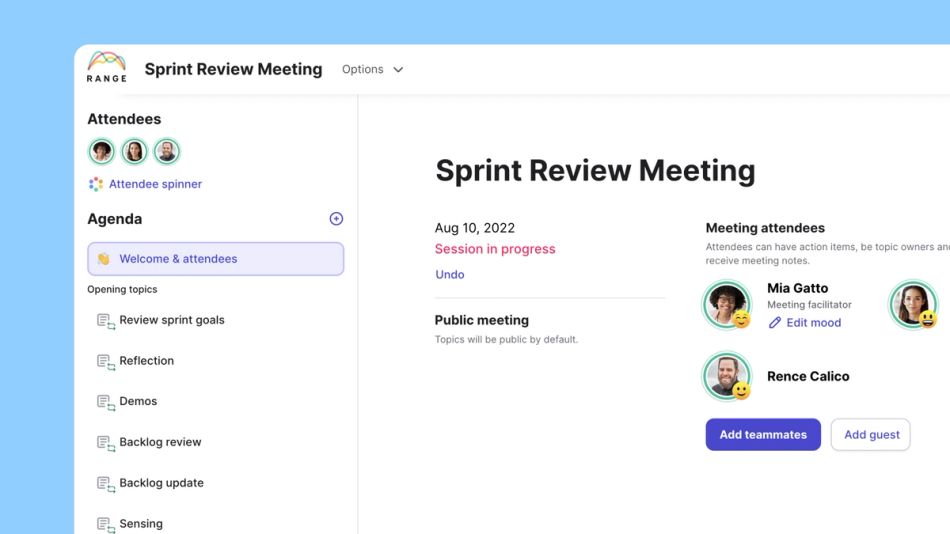
Everyone likes seeing progress. It gives the stakeholders peace of mind that the project is moving forward and proves that they shouldn’t worry about it falling short of their expectations.
Software development teams involved in large, complex projects often designate scrum teams to tackle facets of the initiative. A significant part of the process is conducting a sprint review meeting.
Knowing what a sprint review is, why teams should use them, and what to include in them are crucial elements to conducting ones that hit their mark. Let’s dive deeper into these topics now.
See how Chris Bee, CTO of Lessen, works on his sprints.
“I've thought a lot about this over the years,” shares Chris. “I’ve experimented with a lot of different approaches, borrowed some best practices from others, and melded them together into this recipe that we follow here at Lessen.”
What happens during a successful sprint review meeting?
Sprint review meetings are working sessions, and it's up to the individual teams to lay out the meeting and present their information. When crafting the sprint review meeting agenda, be sure to include these three key components for maximum functionality:
1. Present or demo finished work
Give the attendees a bird's-eye view of the product increments up to this point of the project. This portion is when you discuss new features and note the changes and revamps executed within the completed work. Seeing the progress helps stakeholders ask questions and catch anything the team still needs to address. If they don't naturally join the conversation, ask some thoughtful check-in questions to get them started.
2. Review work and product backlog
The product owner then presents the product backlog items and asks for feedback. The stakeholders take the floor for the comment section of the meeting. This part is where the team receives information to add to their next sprint.
3. Identify key takeaways for the future
After they absorb the valuable input from the stakeholders, team members take it and add the necessary changes to the product backlog. They can move on from what they've already accomplished and focus on what they need to finish next. In addition, they can analyze potential opportunities that presented themselves during the review. This information helps increase the efficiency of future sprints.
Benefits of a sprint review meeting
Just like every part of the scrum methodology, sprint review meetings benefit everyone who has a stake in the project’s success. Here are just a few positives your team can expect from regular sprint review meetings.
1. Learning and improvement
No team is perfect, no matter how experienced, dedicated, and determined. There’s always room to improve processes, save time and resources, and return a higher quality deliverable. Sprint review meetings allow team members to learn what they did that was right so they can replicate it in future projects. They also see where they fell short and can address it and improve for next time.
2. Stakeholder engagement
You don't get face time with clients and other stakeholders during your daily standup meetings, but it's imperative for you to know their opinions and ideas.
Being in front of external and internal stakeholders and having a chance to collaborate with them on the sprint offers priceless insights teams wouldn't get any other way.
Good communication plays a critical role in project management. It lays the foundation for successful projects that come in on budget and by the deadline. By talking with stakeholders, the scrum team can ensure they're going in the right direction with the project and, if they aren’t, can turn things around. Working closely with stakeholders keeps projects on track and maximizes resources.
3. Team building and collaboration
Sprint review meetings give the scrum team a chance to celebrate milestones and enjoy the results of their hard work. In addition, the feedback helps team members align their work with the project’s focus.
Being united in the project’s success helps the team grow stronger and more confident with each other (and within themselves), improving how the team works.

Use Range’s free sprint review template
The scrum framework offers immense advantages to teams, and the sprint review meeting is an important element.
By understanding their purpose, who should attend, and how they should work, the scrum team can become a more cohesive, higher-functioning unit and deliver top-tier results.
⭐️ Simplify your team planning & sprint review meetings
⚡️ Check out Range’s free sprint review template.
Sprint Review Meeting FAQ
What is a sprint review meeting?
In agile project management, a sprint review meeting is one of the scrum ceremonies. It's an informal meeting where the development team walks through their progress during the sprint. According to the scrum guide, the purpose of a sprint review is "to inspect the outcome of a sprint and determine future adaptations."
During the review, the scrum team showcases what they’ve finished, compares where they are where they said they would be in the project, and discusses the items awaiting completion. This meeting happens toward the end of the sprint but before the sprint retrospective.
Why have a sprint review meeting?
The purpose of the sprint review, like sprint planning and sprint retrospective meetings, is to facilitate project management efforts. It gives the team an opportunity to get in front of and converse with key stakeholders, so they can offer input and ask questions. In addition, teams can review the sprint goal and measure their efforts against it to determine items that still need tackling. These meetings are also a place to discuss if the deliverable meets the definition of "done."
Who is involved in sprint review meetings?
There are several people, both from the vendor and client camps, who need to attend a sprint review meeting.
The scrum master, the entire development team, the product owner, and every project stakeholder should be present. The scrum master is accountable for keeping the meeting on track, the product owner gives the demo, and the scrum team should be there to absorb feedback.
It's valuable for the entire team to attend so they can hear the feedback and questions. This keeps everyone working with uniform information and on the same page.
The meeting can be on-site or remotely, depending on where the attending team members are located.
How long should a sprint review meeting be?
Sprint review meetings vary in length based on the sprint itself. The Scrum Alliance recommends scheduling one hour’s worth of meeting time for every week of the sprint. So, a three-week sprint would get a three-hour sprint review meeting. However, the meetings should be time-boxed to a four-hour maximum.








